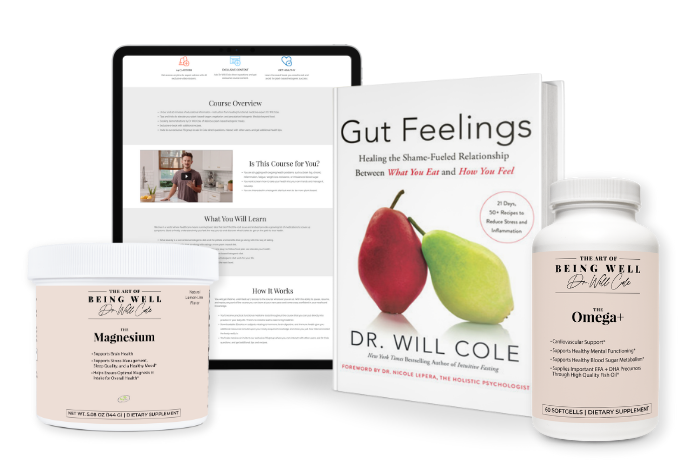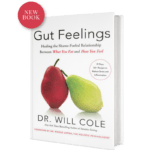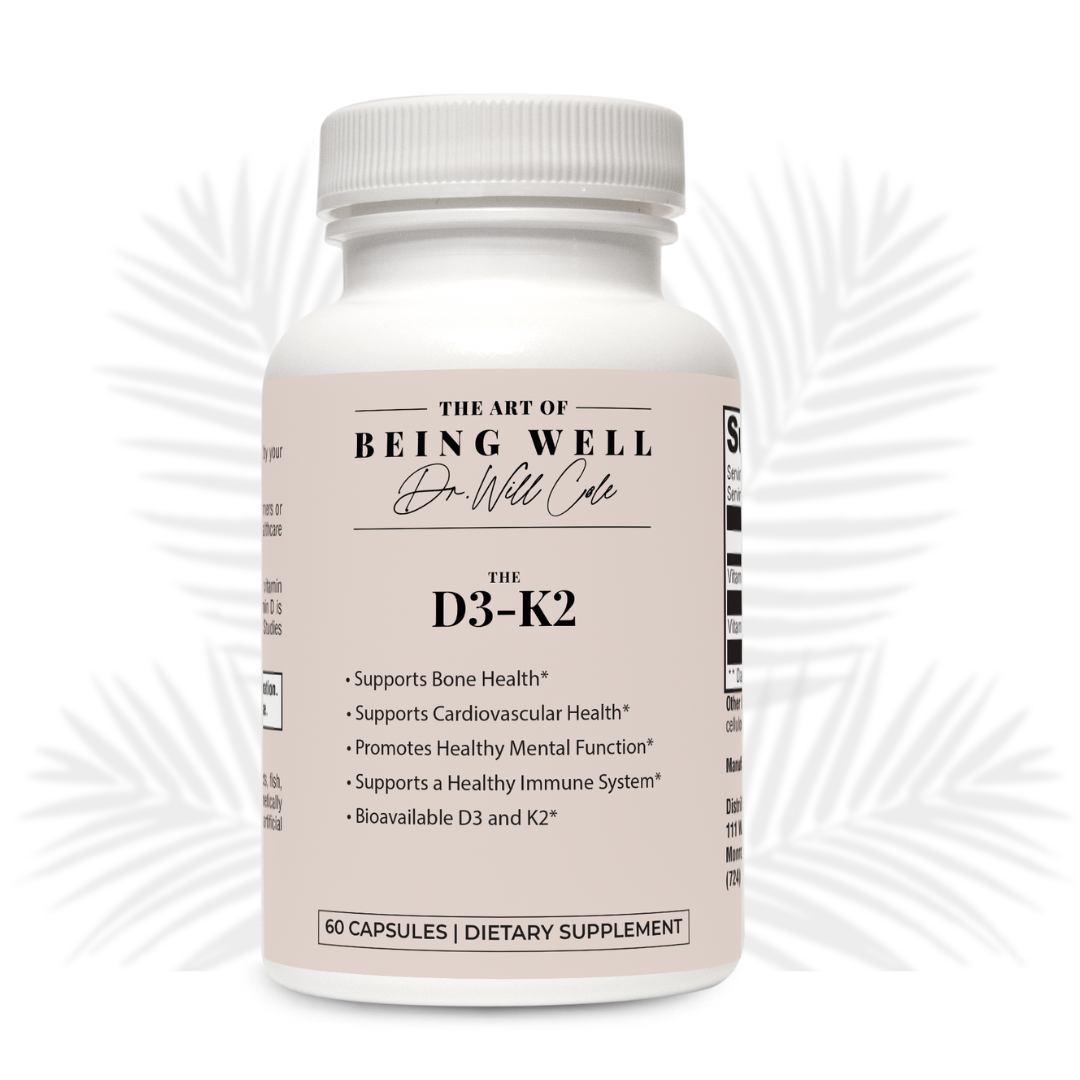Beat The Winter Blues With Our Favorite Functional Medicine Self-Care Tips + Supplements

At first, winter feels magical. I mean, what’s not to love? There’s hot cocoa, crackling fireplaces, and snow gently falling outside. But fast forward three months and most of us are starting to feel a little stir-crazy, sick, and sad. Our skin is dry, our noses are running, and we absolutely yearn to get outside and feel the sun on our skin.
If you can relate to this, you’re not alone. In fact, around 5% (1) of Americans - approximately 10 million people - struggle with seasonal affective disorder, also known as SAD, that lasts for close to 40% of the year. It is also estimated that upwards of 20% of people wrestle with a milder form of SAD known as the “winter blues.”
As a functional medicine practitioner, it’s my job to help my patients feel good all year long. And yes, that means through the entire winter - no matter if you live in Florida or Minnesota. If you’re feeling the winter blues come on, read on to learn more about seasonal affective disorder and my best functional medicine tips to thrive, not just survive, this time of year.
What is seasonal affective disorder?
Seasonal Affective Disorder is a subtype of depression that is characterized by a recurring pattern of depressive symptoms that coincide with the changing seasons and a decrease in natural daylight. SAD typically begins and ends for people around the same time every year, with the highest rates of this condition happening in women, as they are four times more likely to be diagnosed than men. Symptoms of SAD usually include:
- Feelings of sadness or hopelessness
- Chronic fatigue
- Difficulty waking up in the morning
- Weight gain
- Changes in appetite (including more carbohydrate cravings)
- Irritability
- Trouble concentrating
- Increased sensitivity to light
- Loss of interest in activities you once enjoyed
- Social withdrawal
- Suicidal thoughts (in extreme cases)
While there is no single, definitive answer on what causes seasonal affective disorder, researchers and functional medicine experts alike understand that there are multiple factors, most often related to a change in order hormones, that can play a role in the development and severity of SAD.
For example, your endocrine system – the name for your entire hormonal system, including such sub-systems as your thyroid, adrenals, and sex hormones – is greatly affected by sunlight. A study (2) published in the Proceedings of the Royal Society found that shorter days increased levels of both melatonin (the sleep hormone) and DHEA (a sex hormone precursor produced by your adrenals), and also caused actual physical changes to the adrenal glands, which are part of your main stress-response system. These changes lead to further hormone fluctuations downstream, and all that hormonal shifting can have a noticeable impact on your mood.
Several studies (3) have also found that levels of iodine, an essential nutrient for healthy thyroid hormones, and TSH, (4) the brain hormone needed to wake up the thyroid, were both adversely affected during winter months. Another factor is the “happy” brain hormone or neurotransmitter, serotonin. SERT (serotonin transporters) levels in people with SAD were shown to be 5 percent higher (5) in the winter. The higher levels of serotonin in the winter indicate less serotonin in the brain, which can lead to feelings of depression. Ultimately, all of these hormonal changes can leave you feeling SAD and blue.
Tips to overcome seasonal affective disorder
Even though we can't fast forward through the winter months, there are thankfully many natural tools we can utilize during this time of year to improve our moods and overall wellbeing.
1. Stimulate your vagus nerve
Have you heard of the vagus nerve? It’s a nerve that travels all over your body but is most famous for connecting your brain to your GI system. Simulating this nerve has been shown (6) to be an effective treatment for depression. You can do this through modalities like pulsed electromagnetic field and also by doing practices such as deep breathing exercises and intermittent fasting.
2. Exercise (even if it’s just a little)
I know you don’t want to (who wants to exercise when it’s freezing outside?!) but when it comes to supporting your mood, there’s nothing more important than getting your body moving. It doesn’t have to be anything fancy; in fact, it could be as simple as a 10-minute at-home HIIT workout or a dance party around the kitchen.
3. Lean on TCM
Traditional Chinese medicine includes many different healing modalities, but the most famous is probably acupuncture. Acupuncture has been linked (7) to an increase in serotonin and dopamine, two neurotransmitters we want to support in the winter. But how well does this really work? Pretty well. In fact, one study (8) on treatment-resistant patients found that depression was reduced after just one 30-minute acupuncture session.
4. Get a massage
Many of us think of a massage as a huge luxury, but it’s time we start thinking of it as part of our winter self-care routines. Research has shown that bodywork not only lowers cortisol - your body’s main stress hormone - it boosts (9) dopamine and serotonin, which means a happier you.
5. Try taking some adaptogens
Adaptogens are a group of herbs and plants that are meant to help your body deal with stress. My two favorites for winter are Mucuna pruriens - which contains high levels of L-DOPA, a precursor to dopamine - and holy basil. In a 2008 study (10), a dose of 1 gram of holy basil for two months lowered symptoms of anxiety, depression, and stress.
That's one of the reasons I developed an adaptogenic blend of my own with Agent Nateur, called holi (y o u t h) that contains spirulina, marine collagen, and pearl along with holy basil to take advantage of its calming benefits.
6. Take St. John’s wort
Speaking of herbs, you’ve probably already heard of St. John’s wort, a natural supplement that’s been used for years as an alternative to antidepressant medications. While more research needs to be done, the studies we do have point to its ability to reduce depression (11).
7. Don’t forget your vitamin D
Vitamin D’s nickname is the “sunshine vitamin” because we get it when direct sunlight comes into contact with our skin. Knowing this, it’s no surprise that our levels are often low in the winter. You can focus on eating vitamin D-rich foods like egg yolks and wild-caught fish, but many of us still require a supplement. In my practice, I like my patient’s levels to be between 60 and 80 ng/mL, which can require a dose of anywhere between 2,000 and 6,000 IUs of vitamin D per day.
8. Get a lightbox
In the winter it’s not uncommon to leave for work in the dark and come home long after the sun has set. Instead of letting your only light exposure be the fluorescent lighting in your office, try getting a lightbox. They have been shown in many studies (12) to help alleviate SAD. If you can’t get some real sun, this might be the next best thing.
9. Drink more tea
After you’ve worked out, taken your vitamin D supplement, and used your lightbox, it’s time to cuddle up on the couch with a warm glass of organic tea. Luckily, this can also support your mood. L-theanine, a compound found in green, black, and white tea was shown to improve (13) neurotransmitters like glutamate, which can be out of balance in people with SAD.
10. Support methylation
Methylation is your body’s biochemical superhighway that is responsible for multiple different aspects of your health, including making serotonin. B vitamins are what primarily fuel methylation. These can be found in abundance in grass-fed beef, organ meat, and dark leafy greens like spinach.
11. Fuel your brain
About 60 percent of your brain is made up of fat and close to 25 percent of your body’s total cholesterol is located in your brain. In order to fight SAD you need to fuel your brain with healthy fats to give serotonin an environment to thrive in.
In my book Ketotarian, I write a lot about the difference between healthy fats and unhealthy fats and why low-fat diets wreck your brain. Omega-3s are pretty much the epitome of a healthy fat; they are essential for optimal brain health and fend off symptoms like brain fog and fatigue. They’re found naturally in fatty fish like salmon and sardines. If you don’t eat a lot of fish, I recommend supplementing with 2250 mg EPA and 750 mg DHA per day during the winter for brain health and anti-inflammatory support.
12. Up your protein intake
Protein sources like meat and fish contain an amino acid called tyrosine which helps your body make DOPA which is then converted to your neurotransmitter, dopamine. The highest food sources are cage-free organic eggs, grass-fed ground beef, and wild-caught salmon. If you eat a more plant-based diet, legumes, nuts, and seeds also contain tyrosine.
13. Heal your gut
Your gut is often referred to as your “second brain since approximately 95 percent of serotonin is produced and stored in your gut. Keeping your gut healthy will help alleviate SAD.
To make sure the good bugs in your gut are outnumbering the bad ones, try incorporating probiotic-rich foods—like kefir and sauerkraut and a probiotic supplement into your routine. Opt for a supplement with at least 10 billion CFUs and take it daily.
14. Inhale happy
Time to place an order for some essential oils! Research has shown (14) that diffusing lavender essential oil can have an antidepressant-like effect.
15. Spice it up with curcumin
You’ve probably heard of curcumin, the main anti-inflammatory compound in turmeric. If you want to fend off inflammation, a curcumin supplement - along with an anti-inflammatory diet - is the way to go. Curcumin has shown promise for a wide range of inflammatory-based issues, like depression and anxiety (15) and arthritis (16).
I recommend incorporating turmeric into your diet throughout the winter and supplementing it if you need extra support. To make sure you’re getting the most out of what you’re taking, you should always look for a supplement that combines turmeric with black pepper to increase absorption, like my supplement, The Curcumin.
16. Talk it out with Cognitive Behavior Therapy (CBT)
Although more research needs to be done surrounding Cognitive Behavior Therapy, initial studies have shown great promise in using this as a tool to improve seasonal affective disorder. This approach focuses on helping you overcome hurtful thought patterns and behaviors by empowering you with tools to understand and change your thought processes.
One study published in the American Journal of Psychiatry (17) found that after two winters of CBT therapy, individuals had greater improvement and fewer recurrences of SAD symptoms - especially when compared to light therapy - making this an effective tool for long-term, sustainable healing.
18. Get a dawn simulator
By simulating the rising sun, dawn simulators gradually increase your exposure to light in order to gently wake you up, reset your circadian rhythm, promote better sleep quality, enhance your energy levels, and ultimately help alleviate the symptoms of SAD. Studies have even found dawn simulators were able to improve (18) symptoms of SAD on par with light therapy. Make sure to get one with full-spectrum light since that is the most similar to natural sunlight
19. Prioritize social activities
Whether it’s a one-on-one coffee date with a friend or a bigger group activity, staying social is important for your mental health. Even though getting out and socializing might be the last thing you want to do, research has long concluded (19) that your level of social activity is directly linked to your risk for developing depression. Just remember to choose your company wisely as toxic relationships are the antithesis of self-care!
As one of the first functional medicine telehealth clinics in the world, we provide webcam health consultations for people around the globe.
View More At Our Store
Purchase personally curated supplements
and Dr. Will Cole’s books!

- American Psychiatric Association "Seasonal Affective Disorder" Accessed November 2023. https://www.psychiatry.org/patients-families/seasonal-affective-disorder
- Rendon, Nikki M et al. “The agonistic adrenal: melatonin elicits female aggression via regulation of adrenal androgens.” Proceedings. Biological sciences vol. 282,1819 (2015): 20152080. doi:10.1098/rspb.2015.2080
- KM Behall, DJ Scholfield, JG Hallfrisch, JL Kelsay, S Reiser, Seasonal variation in plasma glucose and hormone levels in adult men and women, The American Journal of Clinical Nutrition, Volume 40, Issue 6, 1984, Pages 1352-1356, ISSN 0002-9165, https://doi.org/10.1093/ajcn/40.6.1352
- Paun, Diana L. et al. "The evidence of TSH variation according to the temperature and geographic region in patients with thyroid pathology" Endocrine Abstracts (2010) 22 P774
- European College of Neuropsychopharmacology (ECNP). "Biochemical cause of seasonal depression (SAD) confirmed by researchers." ScienceDaily. ScienceDaily, 20 October 2014. <www.sciencedaily.com
/ releases / 2014 / 10 / 141020212412.htm>. - Manta, Stella et al. “Enhancement of the function of rat serotonin and norepinephrine neurons by sustained vagus nerve stimulation.” Journal of psychiatry & neuroscience : JPN vol. 34,4 (2009): 272-80.
- Wen, G., He, X., Lu, Y., Xia, Y. (2010). Effect of Acupuncture on Neurotransmitters/Modulators. In: Xia, Y., Cao, X., Wu, G., Cheng, J. (eds) Acupuncture Therapy for Neurological Diseases. Springer, Berlin, Heidelberg. https://doi.org/10.1007/978-3-642-10857-0_5
- Yeung, Albert S et al. “A pilot study of acupuncture augmentation therapy in antidepressant partial and non-responders with major depressive disorder.” Journal of affective disorders vol. 130,1-2 (2011): 285-9. doi:10.1016/j.jad.2010.07.025
- Field, T et al. “Massage therapy effects on depressed pregnant women.” Journal of psychosomatic obstetrics and gynaecology vol. 25,2 (2004): 115-22. doi:10.1080/01674820412331282231
- Bhattacharyya, D et al. “Controlled programmed trial of Ocimum sanctum leaf on generalized anxiety disorders.” Nepal Medical College journal : NMCJ vol. 10,3 (2008): 176-9.
- Linde, Klaus et al. “St John's wort for major depression.” The Cochrane database of systematic reviews vol. 2008,4 CD000448. 8 Oct. 2008, doi:10.1002/14651858.CD000448.pub3
- Pjrek, Edda et al. “The Efficacy of Light Therapy in the Treatment of Seasonal Affective Disorder: A Meta-Analysis of Randomized Controlled Trials.” Psychotherapy and psychosomatics vol. 89,1 (2020): 17-24. doi:10.1159/000502891
- Hidese, Shinsuke et al. “Effects of chronic l-theanine administration in patients with major depressive disorder: an open-label study.” Acta neuropsychiatrica vol. 29,2 (2017): 72-79. doi:10.1017/neu.2016.33
- López, Víctor et al. “Exploring Pharmacological Mechanisms of Lavender (Lavandula angustifolia) Essential Oil on Central Nervous System Targets.” Frontiers in pharmacology vol. 8 280. 19 May. 2017, doi:10.3389/fphar.2017.00280
- Fusar-Poli, Laura et al. “Curcumin for depression: a meta-analysis.” Critical reviews in food science and nutrition vol. 60,15 (2020): 2643-2653. doi:10.1080/10408398.2019.1653260
- Daily, James W et al. “Efficacy of Turmeric Extracts and Curcumin for Alleviating the Symptoms of Joint Arthritis: A Systematic Review and Meta-Analysis of Randomized Clinical Trials.” Journal of medicinal food vol. 19,8 (2016): 717-29. doi:10.1089/jmf.2016.3705
- Rohan, Kelly J et al. “Outcomes One and Two Winters Following Cognitive-Behavioral Therapy or Light Therapy for Seasonal Affective Disorder.” The American journal of psychiatry vol. 173,3 (2016): 244-51. doi:10.1176/appi.ajp.2015.15060773
- Danilenko, K V, and I A Ivanova. “Dawn simulation vs. bright light in seasonal affective disorder: Treatment effects and subjective preference.” Journal of affective disorders vol. 180 (2015): 87-9. doi:10.1016/j.jad.2015.03.055
- Ryu, Euijung et al. “The importance of social activity to risk of major depression in older adults.” Psychological medicine vol. 53,6 (2023): 2634-2642. doi:10.1017/S0033291721004566
The information on this website has not been evaluated by the Food & Drug Administration or any other medical body. We do not aim to diagnose, treat, cure or prevent any illness or disease. Information is shared for educational purposes only. You must consult your doctor before acting on any content on this website, especially if you are pregnant, nursing, taking medication, or have a medical condition.
Our content may include products that have been independently chosen and recommended by Dr. Will Cole and our editors. If you purchase something mentioned in this article, we may earn a small commission.

BY DR. WILL COLE
Dr. Will Cole, DNM, IFMCP, DC is a leading functional medicine expert who consults people around the globe, starting one of the first functional medicine telehealth centers in the world. Named one of the top 50 functional and integrative doctors in the nation, Dr. Will Cole provides a functional medicine approach for thyroid issues, autoimmune conditions, hormonal imbalances, digestive disorders, and brain problems. He is also the host of the popular The Art of Being Well podcast and the New York Times bestselling author of Intuitive Fasting, Ketotarian, Gut Feelings, and The Inflammation Spectrum.

Gut Feelings
Healing The Shame-Fueled Relationship
Between What You Eat And How You Feel

